Top Rankings
Wyoming School District ranks among the top 20% of public school district in Michigan for:
Category
Attribute
Diversity
Most diverse schools (Top 1%)
Community Size
Largest student body (number of students) (Top 1%)
For the 2025 school year, there is 1 public preschool serving 284 students in Wyoming School District. This district's average pre testing ranking is 3/10, which is in the bottom 50% of public pre schools in Michigan.
Public Preschool in Wyoming School District have an average math proficiency score of 22% (versus the Michigan public pre school average of 32%), and reading proficiency score of 27% (versus the 40% statewide average).
Minority enrollment is 62% of the student body (majority Hispanic), which is more than the Michigan public preschool average of 39% (majority Black).
Overview
This School District
This State (MI)
# Schools
7 Schools
1,089 Schools
# Students
3,778 Students
372,198 Students
# Teachers
220 Teachers
24,811 Teachers
Student : Teacher Ratio
17:1
17:1
District Rank
Wyoming School District, which is ranked within the bottom 50% of all 851 school districts in Michigan (based off of combined math and reading proficiency testing data) for the 2021-2022 school year.
The school district's graduation rate of 78% has increased from 69% over five school years.
Overall District Rank
#649 out of 866 school districts
(Bottom 50%)
(Bottom 50%)
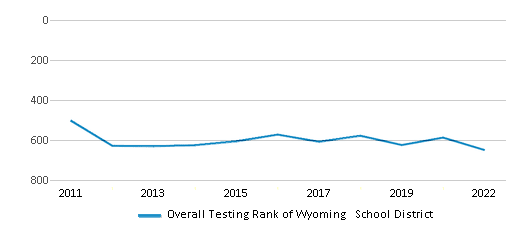
Math Test Scores (% Proficient)
18%
34%
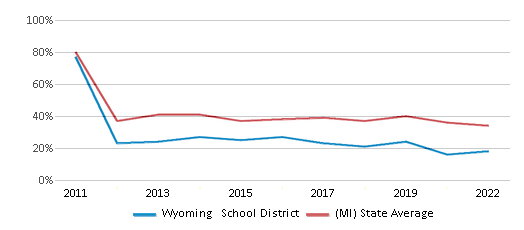
Reading/Language Arts Test Scores (% Proficient)
28%
45%

Science Test Scores (% Proficient)
20%
38%
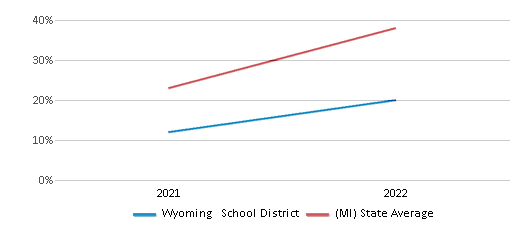
Graduation Rate
78%
81%
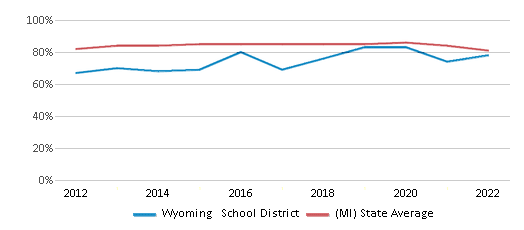
Students by Ethnicity:
Diversity Score
0.68
0.58
# American Indian Students
8 Students
2,804 Students
% American Indian Students
n/a
1%
# Asian Students
67 Students
11,161 Students
% Asian Students
2%
3%
# Hispanic Students
1,810 Students
33,151 Students
% Hispanic Students
48%
9%
# Black Students
665 Students
79,200 Students
% Black Students
18%
21%
# White Students
955 Students
225,969 Students
% White Students
25%
61%
# Hawaiian Students
3 Students
334 Students
% Hawaiian Students
n/a
n/a
# Two or more races Students
270 Students
19,240 Students
% of Two or more races Students
7%
5%
Students by Grade:
# Students in PK Grade:
-
-
# Students in K Grade:
260
69,777
# Students in 1st Grade:
265
60,475
# Students in 2nd Grade:
266
57,993
# Students in 3rd Grade:
274
50,568
# Students in 4th Grade:
284
49,172
# Students in 5th Grade:
290
42,380
# Students in 6th Grade:
310
13,776
# Students in 7th Grade:
267
8,200
# Students in 8th Grade:
279
7,855
# Students in 9th Grade:
323
2,836
# Students in 10th Grade:
307
2,672
# Students in 11th Grade:
306
2,566
# Students in 12th Grade:
347
2,595
# Ungraded Students:
-
1,333
District Revenue and Spending
The revenue/student of $17,993 in this school district is less than the state median of $18,510. The school district revenue/student has grown by 5% over four school years.
The school district's spending/student of $19,524 is higher than the state median of $17,693. The school district spending/student has grown by 5% over four school years.
Total Revenue
$68 MM
$25,476 MM
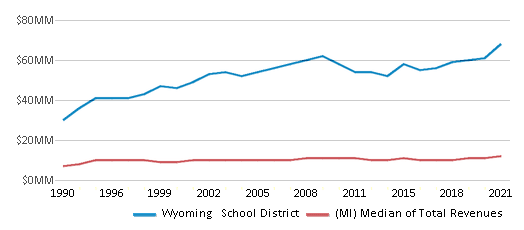
Spending
$74 MM
$24,351 MM
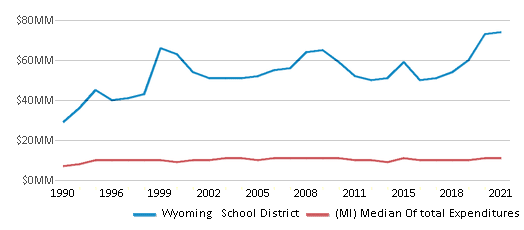
Revenue / Student
$17,993
$18,510
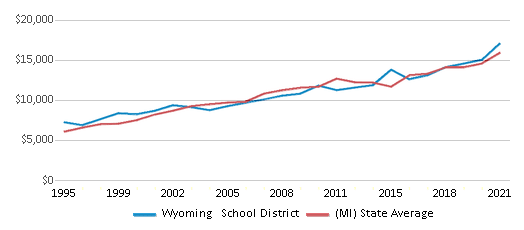
Spending / Student
$19,524
$17,693

Best Wyoming School District Public Preschools (2025)
School
(Math and Reading Proficiency)
(Math and Reading Proficiency)
Location
Grades
Students
Rank: #11.
Oriole Park Elementary School
(Math: 20-24% | Reading: 25-29%)
Rank:
Rank:
3/
Bottom 50%10
1420 40th St Sw
Wyoming, MI 49509
(616) 530-7558
Wyoming, MI 49509
(616) 530-7558
Grades: PK-4
| 284 students
Recent Articles

Year-Round Or Traditional Schedule?
Which is more appropriate for your child? A year-round attendance schedule or traditional schedule? We look at the pros and cons.

Why You Should Encourage Your Child to Join a Sports Team
Participating in team sports has a great many benefits for children, there is no doubt. In this article you will learn what those benefits are.

White Students are Now the Minority in U.S. Public Schools
Increasing birth rates among immigrant families from Asia and Central and South America, combined with lower birth rates among white families, means that for the first time in history, public school students in the United States are majority-minority. This shift in demographics poses difficulties for schools as they work to accommodate children of varying language abilities and socio-economic backgrounds.





